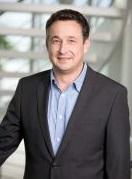Sponsor Symposiums
Dr Stefan Launer
Phonak AG, Vice President Advanced Concepts and Technologies Phonak AG, Zurich

Stefan Launer studied Physics with a focus on Medical Physics in Gottingen and later one in Oldenburg. He finishedhis PhD-thesis on Loudness Perception in Hearing-Impaired Subjects• with the development of a loudness-model which accounts for hearing impairment. Since June 1995 he is in various functions with Phonak's Research and Development, currently responsible for coordinating Phonak's I Sonova's corporate research and technology program including hearing instrument technology, wireless technology as well as implants.
Before that, he was heading the department signal Processing• and in that function in charge of research and development related to audiological and clinical procedures of hearing instrument fitting and evaluation as well as the development offuture digital signal processing algorithms for hearing instruments.
STATE OF THE ART IN HEARING INSTRUMENT TECHNOLOGY
Digital technology offers many possibilities to optimally fit hearing instruments to the individual listening needs of hearing impaired persons. Today's hearing instruments contain many different adaptive control functions which automatically adapt the hearing instruments operational parameter settings according to the requirements of the respective acoustic environment
Identifying the acoustic environment for selecting the optimal signal processing strategy requires an intelligent decision making process about the acoustic environment relying on different physical characteristics of the sound field. The automatic identification of the acoustic environment is a very important pre-requisite for the application of sound cleaning features, i.e. signal processing techniques improving the listener's communication abilities in adverse listening conditions. Such techniques include the adaptive multi-microphone technology which significantly improves the performance of noise reduction systems.
Latest technologies also include means for reducing the very detrimental effect of reverberation on speech intelligibility especially for hearing impaired people. Recent studies clearly show an improvement in subjective and objective speech intelligibility in a variety of difficult listening situations. Recently Frequency Compression has been successfully re-introduced into hearing instruments specifically improving speech intelligibility and speech production in subjects with profound hearing losses. Furthermore wireless links between left/right hearing instruments and also to external devices have been introduced opening up a range of new applications. Finally, hearing instrument technology has significantly made progress regarding the mechanical design, robustness and wearing comfort offering new solutions for age old problems such as occlusion and cosmetic appearance.
Professor Graeme Clark
Inventor and pioneer of the multichannel cochlear implant
Let There Be Sound, Cochlear Symposium
Featuring keynote speaker Professor Graeme Clark, inventor and pioneer of the multichannel cochlear implant. Come and meet Professor Clark who will be our special guest on the Cochlear booth from 12.00pm - 1.30pm.








